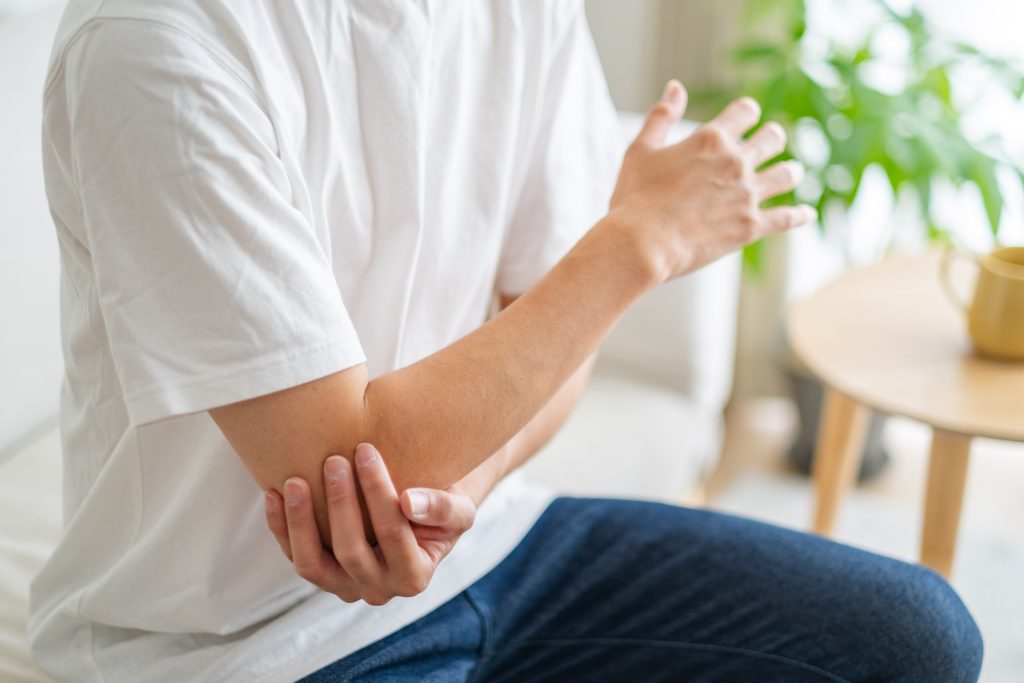The causes of elbow pain are numerous and can be difficult to understand what’s going on, but when it’s also stiff, that may help narrow down the condition you’re dealing with. External injuries like bruises and scrapes may hurt, but stiffness often comes from within the joint.
Causes of elbow stiffness
Several conditions can lead to the uncomfortable combination of elbow stiffness and pain. Here are the most frequent culprits:
Arthritis
Arthritis is one of the leading causes of elbow joint stiffness and pain. The two main types affecting the elbow are osteoarthritis and rheumatoid arthritis.
Osteoarthritis occurs when the tissues in the elbow joint begin to wear down, including the cartilage that cushions your elbow joint. You might notice your elbow feels particularly stiff in the morning or after periods of inactivity.
Rheumatoid arthritis is an autoimmune condition that results in chronic inflammation that can damage cartilage and bone in the affected joints over time. Unlike osteoarthritis, rheumatoid arthritis often affects multiple joints symmetrically and can cause fatigue and other systemic symptoms.
Post-surgical scarring
If you’ve had elbow surgery in the past, scar tissue formation is a common cause of ongoing stiffness and pain. Surgical procedures, while necessary for treating injuries or conditions, can lead to adhesions and fibrotic tissue that restricts normal joint movement.
Post-surgical scarring can develop weeks or months after your procedure. The scar tissue may form around tendons, ligaments, or within the joint itself. This internal scarring creates a mechanical barrier that prevents your elbow from moving through its full range of motion, resulting in stiffness and discomfort.
Previous injury
Various types of injuries can cause lasting elbow stiffness and pain. Fractures, dislocations, and severe sprains can all lead to joint complications that persist long after the initial injury heals.
- Elbow fractures, particularly those involving the joint surface, can cause irregular bone healing or bone spurs that interfere with smooth joint movement. Even after the bone heals, you may experience ongoing stiffness due to changes in the joint’s normal anatomy.
- Dislocations can stretch or tear the ligaments and joint capsule, leading to chronic instability and compensatory stiffness. Your body may naturally limit elbow movement to protect the joint from further injury.
- Severe muscle or tendon injuries around the elbow can also contribute to stiffness. Conditions like tennis elbow or golfer’s elbow, when left untreated, can cause protective muscle guarding that restricts normal joint movement.
How to treat elbow stiffness
Elbow stiffness can feel frustratingly deep-seated, as if it’s coming from within the joint where at-home treatments like ice packs can’t seem to “reach.”
Rest is also key to avoid aggravated injured or damaged parts of the elbow. However, completely isolating the joint may result in increased stiffness, which is why the combination of both pain and stiffness often requires professional help.
Heat therapy can be helpful for elbow stiffness, as warmth helps relax tight muscles and improve blood flow to the area.
And if at-home care isn’t providing adequate relief, physical therapy is the next step for seeking care and remedies for elbow pain. Physical therapists have specialized training in joint mobilization techniques and can address the underlying causes of stiffness more effectively than self-treatment alone.
What to expect from elbow stiffness treatments at physical therapy
Physical therapy offers a comprehensive approach to treating elbow joint stiffness and pain through various evidence-based techniques, such as:
- Manual therapy
- Joint mobilization techniques
- Soft tissue mobilization
- Therapeutic exercises
- Expert-guided heat and ice therapy
- Injury prevention education
Your therapist will design a progressive exercise program that gradually improves your elbow’s range of motion while strengthening the surrounding muscles. These exercises are carefully calibrated to challenge your joint without causing additional inflammation or pain.
In addition, you may ask about ergonomic recommendations or sport-specific therapy that may be relevant to the lifestyle you want to live once your elbow stiffness and pain are resolved.
Elbow rehabilitation at Franklin Rehab
When your joints are both stiff and painful, your normal routine gets a lot harder and worse. But if you live in Franklin, WI, you have an option for treatment in the neighborhood.
No matter what’s causing your joint pain, we have the expertise to get you back to your normal life with less pain. Start a conversation about what that might look like for you by calling our clinic or by requesting an appointment online today.
